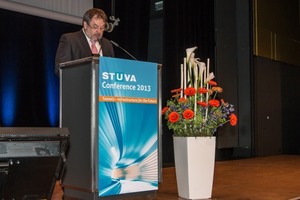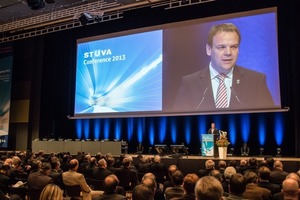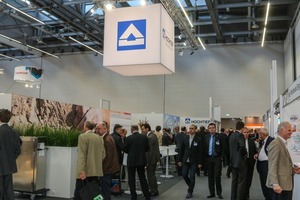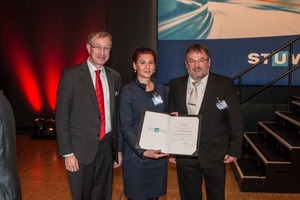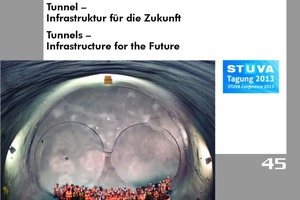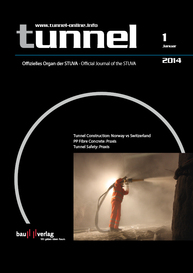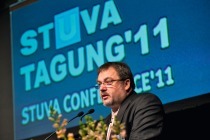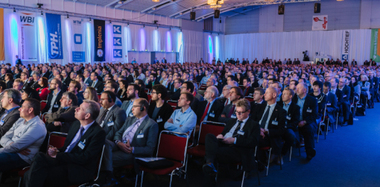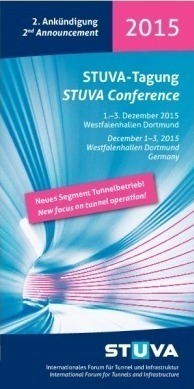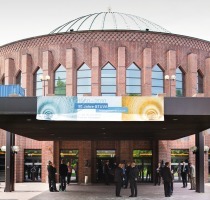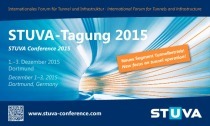The 2013 Tunnellers’ Family Gathering in Stuttgart surpasses all Records
Well over 1,600 participants and 150 leading exhibitors from home and abroad got together in late November 2013 at the ICS in Stuttgart for the 2013 STUVA Conference for an exchange of experience on underground construction with other national and international tunnel experts. This time around, the event concentrated on the Stuttgart 21 mega project. For 3 days delegates talked shop and discussed future strategies. In more than 40 contributions, topical matters affecting the industry were dealt with.
The Expo was always well attended favoured by the location and its close proximity to the assembly hall. A factor further influenced by the qualitatively high quality stands and the professional competence provided there.
In his opening address the chairman of the STUVA board Univ.-Prof. Dr.-Ing. Martin Ziegler also referred to a topic in connection with the Stuttgart–Ulm major project, which concerned experts attending the confe-rence 2 years ago and is still gaining significance: In addition to the many technical challenges, which a tunnelling project of this size affords, the clients still find themselves facing public resistance. During his address Ziegler thus called upon both engineers and above all politicians to ensure that “genuine” citizens` participation is practiced, in the case of which costs, limitations and risks are communicated in a transparent and honest manner. He made it quite clear that in STUVA`s view that each individual is obliged to commit himself to overall social responsibility and not to obstruct progress through partial self-interest (Fig. 1).
Ziegler made it clear that even projects, which had originally been a strong bone of contention, were evaluated positively once they had been successfully completed, providing the destination could be reached in a far shorter period of time.
The necessity for a functioning infrastructure for a flourishing economy was also emphasized in the speech of welcome delivered by Ingo Rust, member of the Landtag and undersecretary in the Ministry of Finance and Economics of the Land of Baden-Württemberg. This was further stressed in that he particularly expressed the regional government’s gratitude for the DB AG’s achievements in conjunction with the Stuttgart-Ulm major project (Fig. 2) to Dr. Volker Kefer, Chairman of the Division for Infrastructure as its representative and the next speaker.
Following undersecretary Rust`s address, Dr. Volker Kefer examined the success factors for major infrastructural projects in the first paper and in the process resorted to findings obtained from the Stuttgart–Ulm mega project. In this connection, he very clearly described how changed political conditions in the region and the city as well as a new cost framework regulation for the Stuttgart rail hub can alter the general conditions (Fig. 3).
The subsequent series of lectures tackled the wide spectrum of underground construction:
International Major Projects
Safety in Tunnelling
Mechanised Tunnelling
Urban Construction and Tunnelling
Citizens’ Participation, legal and contractual Issues
Tunnel Operation, Costs
Tunnel Redevelopment, Tunnel Renovation
The group of subjects “Safety in Tunnelling” was devoted to the DAUB (German Tunnelling Committee). This important society was celebrating its 40th anniversary. Since its inception, one of its most important tasks has been to improve working conditions and the safety of workers underground. On the occasion of the round birthday, a giant birthday cake appeared during the break, which was distributed to all the participants.
The series of papers was rounded off by a block of topics devoted to underground construction in the Stuttgart region.
The high quality of the lectures ensured that there was scarcely a free place in the assembly hall (Fig. 4). The participants displayed their enthusiasm: “A well organized and successful event”; “highly invaluable”; “interesting and diverse”. “The STUVA Conference continues to be an outstanding event for expert information and to exchange views on topical tunnelling themes”. These were just some of the numerous positive opinions that prevailed. On the third day of the event excursions were offered to the Stuttgart-Ulm major project, the new urban transit line U12 beneath the Europa District as a direct follow-up measure to this project; more extensive details on mastering methane gas were provided and it was possible to witness retrofitting of the Heslach Tunnel and the traffic control centre. Many participants chose to take part in the long drive to Schwanau to see a manufacturing plant for tunnel boring machines close up.
Products and services from the underground construction sector were presented within the scope of the STUVA Expo – used as a professional marketing platform by in the interim more than 150 leading exhibitors from home and abroad, who occupied over 2,300 m² of net space, parallel to the series of lectures. In addition to the conference participants, numerous trade visitors took advantage of the opportunity to talk about new trends in the industry with exhibitors and colleagues (Fig. 5).
STUVA Prize 2013
To mark the STUVA Conference, every 2 years the Research Association for Underground Transportation Facilities Inc. – STUVA – presents the STUVA Prize for outstanding achievements and innovations in the field of underground construction in order to promote the idea of the utilization of underground space among experts and the general public (Fig. 7).
The jury awarded the 2013 STUVA Prize to Herrn Baurat h.c. Dipl.-Ing. Dr. mont. George-Michael Vavrovsky in recognition and appreciation of his services to tunnelling.
From 1989 to 2012, Herr Dr. Vavrovsky was board chairman of the Eisenbahn-Hochstrecken AG/the ÖBBInfrastruktur AG applying his outstanding capabilities for developing the railways in Austria, placing his stamp on this era from the very outset extending well into the future.
He embarked on new paths and innovative solutions both in tunnelling and for tackling other geotechnical problems. He scientifically processed these extensive and diversified findings from geotechnical and tunnelling technical problem complexes, especially relating to his collaboration on the approx. 40 km long tunnel structures in Germany, and produced a dissertation at the Montan University Leoben in 1987 on the subject of “Relief, Load Development and Failure Mechanisms in Tunnel Drives with shallow Overburden”. In the same year, the Austrian Society for Geo mechanics (ÖGG) awarded him the Leopold Müller Prize for this work.
These recognitions greatly influenced the planning and excavation of tunnels under such tricky general conditions and provided the basis for technically and economically optimized solutions. Dr. Vavrovsky was also a pioneer for applying and utilizing advances in measure-
ment techno logy for better assessment of rock and system behaviour and for dimensioning supporting measures in Austrian tunnelling. He largely devised the combination of drive-oriented deformation presentation and chronological development. Thanks to his developments, he contributed towards ensuring that tunnelling projects could be tackled more safely and economically.
In addition, he developed systems and methods for enhancing the predictability and the cost stability of transport infrastructure projects. He was encouraged to do this among other things by the major tunnelling projects in Switzerland. Standard publications have emerged from his developments, which are applied by the ÖBB-Infrastruktur AG as well as throughout Austria for transport infrastructure projects:
Handbook for Determining Costs
ÖGG Guideline on Determining Costs for Transport Infrastructure Projects.
The high cost stability continuously attained in project volume since the general plan was introduced in 2005 testifies to the success of these methods.
In addition, Dr. Vavrovsky contributed enormously to many fields and institutions for planning and construction setting lasting standards. He regards top quality planning as one of the main influencing factors for project development exercising a huge effect on costs, quality and duration of the project. He finds that top quality planning starts with establishing intellectual-creative services. For example, he decisively helped draw up the Austrian Federal Procurement Act and the materials contained in the said law in these aspects. He helped draw up codes of practice and standards by successfully providing concepts and values in the framework of committees dealing with standards from the Austrian Institute for Standards as well as in expert groups of the Society of Austrian Engineers and Architects.
His interest in things that are new cannot be stilled. Vision, precision and analytical perception as well as human greatness are Georg-Michael Vavrovsky’s most striking attributes, which allow him to display an almost superhuman range of knowledge with enormous substance.
After completing his construction engineering studies at Graz Technical University, he began his professional career with the Salzburg “Ingenieurbüro für Fels- und Tunnelbau” with Prof. Franz Pacher. These early years were characterized by planning activities for tunnels and rock structures mainly in Austria, Germany and Greece. For many years, he accompanied Prof. Franz Pacher, one of the co-founders of the New Austrian Tunnelling Method (NATM) in his function as tunnel expert on the construction sites of the new Hanover-Würzburg (DB) rail route, as well as deputizing for him at courses at the technical universities in Munich and Vienna.
As a specialist for excava-
ting tunnels close to the surface during this time he was called on to tackle many tricky situations abroad. In 1988, Vavrovsky together with his then partner DI Nejad Ayaydin headed the “Ingenieurbüro für Geotechnik- und Tunnelbau” (IGT) in Salzburg, prior to taking charge of the newly set up Eisenbahn-Hochleistungsstrecken AG in Vienna in 1989.
Vavrovsky still considers it essential to rely on qualified planning and client culture as well as developing a systematic-cybernetic understanding of project management with all its principles and general conditions.
STUVA Young Engineers‘ Prize 2013
As winner of the lecture competition in the “Young Forum”, Frau Mag. (FH) Susanne Fehleisen MAS, Project Management Koralmbahn 3, ÖBB Infrastruktur AG, collected the prize for her contribution “Koralm Tunnel: Application of the Evacuation and Fire Protection Concept for complex Underground Construction Sites taking the Main Contract Section as Example”.
The final choice took place on the basis of an assessment made by the audience attending the lecture series, with the lecture content, the nature of the pictorial presentation and the means of delivery all obtaining marks. Frau Fehleisen was able to convince the audience on all sectors. The prize consists of a trip to Canada to visit out-of-the-ordinary tunnelling sites. We should like to congratulate Frau Fehleisen on winning the prize and trust that her trip will be an interesting and memorable experience (Fig 8).
Proceedings
The Proceedings – Volume 45 in the STUVA book series “Forschung + Praxis, U-Verkehr und unterirdisches Bauen” – with the long versions of all papers (each in the original language German or English and abstracts in the other language) were published to coincide with the Conference and were distributed to all the participants there. Further copies can be obtained via the book trade or directly from the publisher (Bauverlag BV GmbH, Avenwedder Str. 55, 33311 Gütersloh; 296 pp., 313 mostly coloured Ill. and Tables, Format DIN A4, soft cover, ISBN: 978-3-7625-3661-1, Price € 50,-).
STUVA General Assembly 2013
On the occasion of the STUVA Conference `13, the regular STUVA Inc. General Assembly took place on November 26., 2013.
STUVA Board
The period of office of the following board members, elected for a 4-year term, duly came to an end at the 2013 General Assembly:
Dipl.-Ing. Edgar Schömig
Univ.-Prof. Dr.-Ing. Martin Ziegler (chairman)
The above-mentioned gentlemen were confirmed for a further period in office.
As a result, the STUVA Board is constituted as follows:
Univ.-Prof. Dr.-Ing. Martin Ziegler (chairman) till 2017
Dr.-Ing. Karl Morgen (1st deputy chairman) till 2015
Dipl.-Ing. Otto Schließler (2nd deputy chairman) till 2015
Dipl.-Ing. Wolfgang Feldwisch till 2015
Dipl.-Ing. Edgar Schömig till 2017 as well as
Prof. Dr.-Ing. Dr.-Ing. E. h. Günter Girnau (as honorary board member without legislative period)
STUVA Advisory Board
The following gentlemen have stepped down from the STUVA Advisory Board since the 2011 General Assembly:
Dipl.-Ing. Franz Bayer, Max Bögl Bauunternehmung GmbH & Co. KG, Central Division for Tunnelling, Munich/D (retired)
Dr.-Ing. Roland Gärber, Management Bilfinger Construction GmbH, Wiesbaden/D (new duties)
The following new Advisory Board members were elected:
Dipl.-Ing. Bernhard Arenz, BG BAU Berufsgenossenschaft der Bauwirtschaft, Head of Prevention, Berlin/D
Dipl.-Ing. Martin Holfelder, Bilfinger Construction GmbH, Board Chairman for the Tunnelling Division, Munich/D
Dipl.-Ing. Stefan Jacob, Max Bögl Bauunternehmung GmbH & Co. KG, Head of Central Division for Tunnelling, Munich/D
Please note: STUVA Conference ´15
The next STUVA Conference will be held at the Westfalenhallen Dortmund/D from December 1 to 3, 2015

